Eroding indigenous culture in the Sundarban Biosphere Reserve
BY SHABERI DAS AND SUGATA HAZRA • JANUARY 27, 2023
“Culture is also a resource for climate adaptation because cultural heritage, natural heritage and traditional knowledge all support the resilience of communities to respond to climate change impacts, including extreme weather, natural disasters and conflicts”
UNESCO, Culture and Climate Change
Ethnographic survey and action research to enhance climate resilience of the tribal communities in the Sundarbans Biosphere Reserve (SBR) being the chief component of the Sound of Silence (SoS) project, my initial observations in the field have made me wonder if – and what – role culture plays in modifying the vulnerabilities experienced by these communities. This first post is, thus, an attempt to capture the observations and impressions gleaned from my initial interactions with the local communities, and especially their youth, in our study area in the Sundarban Biosphere Reserve (SBR).
Having observed Santhal and Munda communities in other parts of West Bengal in the course of my research work over the years, I noted stark differences in the cultural expression of the same communities in the SBR. In Purulia and Bankura, for instance, the mud homes of the Santhals and Mundas have intricate patterns and even images from folk stories painted on them. They also raise a larger variety of livestock as one of one of the main livelihoods. Their sacred trees and small shrines are prominently located: even a careless visitor cannot miss them. In my exploratory visits to the tribal hamlets in the SBR, none of this was plainly visible, though I did hear that most colonies or villages had at least one shrine to Marang Buru or other tribal gods.
The issue of erosion and loss of tribal cultural heritage and languages in this UNESCO World Heritage Site, was raised early in the course of these visits, chiefly by the elderly. “Our children do not speak the language. They express no interest in our customs and beliefs. With every succeeding generation, the death of our culture is being accelerated,” a retired school teacher from Hingalganj lamented when asked about the community’s cultural practices.
The children and youth we met on these trips always either looked away with an embarrassed smile when questions about their inability to understand or speak their mother tongue fluently emerged or firmly insisted that this inability was owing to the fact that the language is neither the medium of instruction in school nor of communication between them and their elders at home. But in matters of linguistic knowledge and fluency, I noted a lack of conscious awareness about their history and the importance of preserving indigenous languages – language being the repository of culture and the mode of its transmission – and a related lack of motivation to master their own. Repeated emphasis on the need to protect indigenous cultures and ways, laid by the tribal communities themselves, strengthened our resolve to understand more of the causes behind their loss for the vulnerability of these communities can scarcely be properly understood without first understanding their connection, or apparent disconnection, with nature and the forest, of which they are traditionally believed to have been the custodians.


The tribal communities in the Sundarbans are non-native to the region, having been brought from the Chhota Nagpur plateau region by colonial administrators in the late 18th century, to clear the mangrove forests and kill tigers – making the traditional protectors of forests agents of widespread destruction of the forest ecosystem – to establish agriculture (for revenue generation) and human settlement. The majority of these migrant communities could never return home, staying on in the delta as marginal farmers and fishermen, toiling to construct mud embankments to protect agricultural lands for zamindars (landlords), though most had not much – or any – land to call their own and no forest rights. Subsequently, the partition of India and Pakistan in 1947 and the Bangladesh Liberation War in 1971, which spawned an influx of non-tribal migrants from East Bengal (present day Bangladesh) to West Bengal, India, which culturally marginalized these forest-dependent communities and effectively forced them to be assimilated into the dominant culture. But being predominantly landless and unaccustomed to life in the marshes, they continued to suffer acute socioeconomic alienation and environmental vulnerability, having been relegated to the margins of the islands.

Thus, I chose as the starting point of my enquiry tribal youth who appeared to now be carrying on their shoulders – whether or not they realized it – the mighty burden of carrying forward the traditions, rituals and beliefs of their foremothers. However, it was not until early January 2023, during a participatory rural appraisal (PRA) exercise in Kakdwip, that I began to obtain a clearer picture of the problem itself.
Tribal children and youth in the SBR read and communicate in Bengali, a language which, being not theirs, neither chronicles their origins in songs and stories nor imparts to them generational wisdom. Tribal societies in most parts of the delta have taken up Hindu religious practices alongside their own, worshipping the Hindu God Krishna or Shiva and other such deities alongside their supreme deity Marang Buru.
According to the members of these communities, these religious and cultural practices appear to be slowly overshadowing indigenous customs and beliefs, rising from and also fuelling cultural alienation.
Conversations with young school and college-goers gradually also made me appreciate the role of westernization that the digital revolution has brought to rural India, including the SBR, in producing a unique admixture of the traditional and the modern, the rural and the urban, the collective and the individualistic, the dated and the timeless, among millennials and post-millennials, which, alongside assimilation, has introduced sweeping changes to the socio-cultural, linguistic, and religious fabric of indigenous lives.
Migration, intensified by environmental and climate change in the absence of adequate adaptive capacity, is making its own contribution to these changes, too. “My parents do not own much land. They catch fish and crabs from the forest but they do not want me to follow in their footsteps. Some of my friends and cousins are preparing for exams to secure government jobs. But most of us must settle on migration or daily wage work nearby. But local work opportunities run low,” a tribal youth I met in Kakdwip told me. With rising man-animal conflict and fatalities, particularly during and post-pandemic context, and firmer implementation of forest laws, tribal communities are increasingly convinced against letting their youth enter the forest.

Thus, though their livelihood practices appear to have a larger share of forest collection and wage labour in comparison to non-tribals, most tribal households we encountered reported at least one member who had, continues to, or plans on, migrating to work in far-flung areas in northern and southern India. Torn from not just their families and communities but also from the cultural markers that constitute their identity, often in their youth when they first migrate from home, these tribal peoples gradually watch their unique indigenous self fade and transform into nothing but a labouring body, no different from their non-tribal colleagues.

Another notable dimension of cultural corruption is the loss of traditional indigenous sports and skills such as archery and wielding traditional weapons and tools, which are increasingly losing their relevance to Sevens football (played predominantly in Kerala in southern India) and badminton. Oral storytelling and folk performances are also reportedly a rarer sight at local festivals and fairs, their cultural and linguistic significance slowly lost with each succeeding generation. Even the traditional alcohol beverage hariya (rice beer) has begun to face stiff competition from chullu (bootleg rice liquor) and bidi (unprocessed tobacco wrapped in leaves) from marijuana.
What began to emerge from these discussions and PRA activities like participatory mapping of village resources and vulnerability, and constructing a calendar of tribal cultural and religious events and festivals, was a vivid picture of the rich socio-cultural lives of these communities, and the cultural needs and aspirations they wanted to realize, despite having embraced another religion and culture in an unfamiliar land. While one may feel the need to raise awareness among their youth the importance, and ways, of preserving and protecting their language, culture, customs, and knowledge, can it be secured without a script and holy books and generational practices?
More on that soon and until next month. But in the meantime, please share your thoughts and insights with us in the comment section below or write to us at soundofsilenceresearch@gmail.com because every voice matters and none must be silenced!



18 thoughts on “Eroding indigenous culture in the Sundarban Biosphere Reserve”
Im very happy to uncover this site. I wanted to thank you for ones time for this particularly wonderful read!! I definitely appreciated every bit of it and i also have you book marked to see new information in your site.
I am really loving the theme/design of your website. Do you ever run into any internet browser compatibility issues?
A number of my blog audience have complained about my website not operating
correctly in Explorer but looks great in Chrome.
Do you have any tips to help fix this problem?
Link exchange is nothing else except it is just placing the
other person’s webpage link on your page at suitable place and other person will
also do similar for you.
I was recommended this blog by my cousin. I am not sure whether this post is written by
him as no one else know such detailed about my difficulty.
You are amazing! Thanks!
Your site’s position in the search results https://ztd.bardou.online/adm
Cool website. There is a suggestion https://ztd.bardou.online/adm
Here’s what I can offer for the near future https://ztd.bardou.online/adm
Can provide a link mass to your website https://ztd.bardou.online/adm
SEO Optimizers Team https://ztd.bardou.online/adm
Cool website. There is a suggestion https://ztd.bardou.online/adm
Content for your website http://myngirls.online/
Web Development Wizards http://myngirls.online/
Can provide a link mass to your website http://myngirls.online/
Web Development Wizards http://fertus.shop/info/
I was wondering if you ever considered changing the layout of your website?
Its very well written; I love what youve got to
say. But maybe you could a little more in the way
of content so people could connect with it better. Youve got an awful lot of
text for only having 1 or 2 images. Maybe you could space it out better?
Your site’s position in the search results http://fertus.shop/info/
SEO Optimizers Team http://fertus.shop/info/
Hi there to every one, the contents existing at this web site
are truly amazing for people knowledge, well, keep
up the nice work fellows.